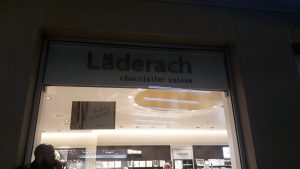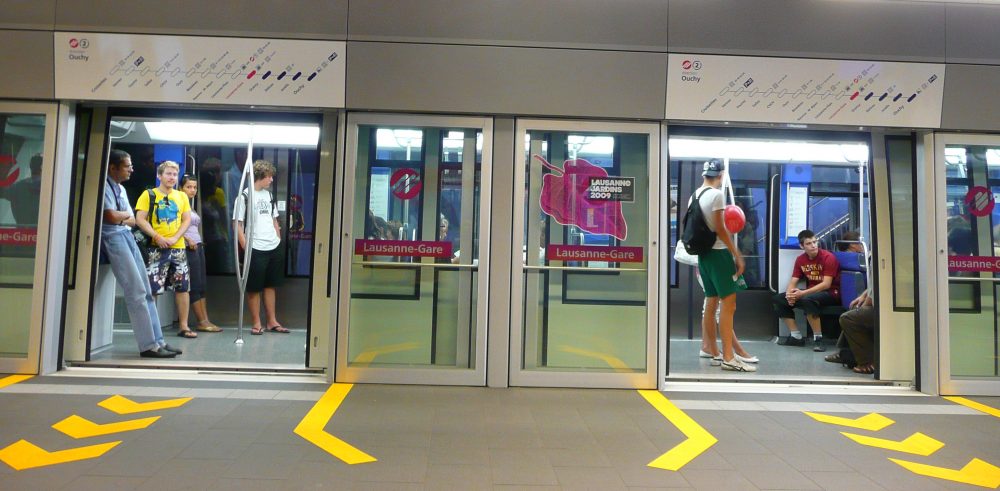Authors : Alba G. and Stallo A.
Abstract
Switzerland is a nation composed by 4 national languages and its linguistic landscape is complex, especially in big and multicultural cities like Lausanne. Having multicultural restaurants and food services amplify the complexity and rich nature of the city’s linguistic landscape. Nevertheless, having more than one language might be challenging, because the restaurants and food services might lose their “authenticity” and origins. Therefore, it is interesting to analyse, through collecting photos of commercial signs and store windows, whether these commercial activities have claimed their native culture in a place where the native languages are not officially recognized. Generally, restaurants (especially Italian and Chinese ones) did succeed in claiming their culture by using their own native language, but results must be considered carefully, because the data analysed was very restricted (only 11 restaurants and food services).
Introduction
The term “multilingualism” has its huge spread throughout the 21st century thanks to technology, new ways of communication and new faster ways of transports. Therefore, the Linguistic landscape as an approach, is relatively new: it originates more than 40 years ago, and it has grown popular in the last 10 years (Gorter, 2006; Gorter & Canoz, 2017). Since Switzerland is a nation with 4 national languages, its linguistic landscape must be quite interesting, especially in big and multicultural cities as in the case of Lausanne. Gorter (2006) explains that studying “the linguistic landscape is also to study cultural heritage. Languages are part of the cultural heritage and the sustainable development of linguistic diversity is seen as an important aspect of our heritage”. Moreover, the Unesco Universal declaration on Cultural Diversity proclaims that “all persons have therefore the right to express themselves and to create and disseminate their work in the languages of their choice” (Unesco, 2002 In Gorter, 2006). Gorter et al. (2012) proclaim that, for minority languages, to be seen is as important as to be heard. However, researches are not yet so interested in the study of “displays of minority languages in the public space” (Gorter et al., 2012).
The research question that we seek to answer in this paper is the following: how do ethnic restaurant, by using the language associated with their national background, reclaim their own culture in a city in which their language is not officially recognized?
In order to answer this research question, different images were gathered from 11 ethnic restaurants or food services found in the city of Lausanne, that were then analysed (not following a specific approach). The choice of ethnic restaurant was made on the basis that, from a naïve point of view, it is in those particular instances that multilingualism would really emerge, showing a plurality of languages (depending on the culture that the restaurant showcases and commodifies).
Theoretical framework
In order to study how ethnic restaurants, construct themselves around instances of multilingualism, it must be understood how ethnic restaurants differs from other types of restoration and what the customer expects from them. Unfortunately, there is still not a body of literature that focuses on the use of different languages in restaurants, but there are various researches that concentrate on authenticity and customers’ perceptions of it.
Muñoz and Wood (2009) discovered that the more customers are geographically distant from an ethnic restaurant’s place of origin, the more they focus on restaurant’s atmospheric components and stereotypes held by the represented culture. Swiss population, which is far away from i.e. China or Spain, will then have strong expectations based on different stereotypes that would be encountered in Chinese restaurants or Spanish cafés.
In order to attract customers, ethnic restaurants are craftly themed. Theming is “the process by which an environment is given a distinct character” (Muñoz & Wood, 2009), and in ethnic restaurants this involves the depiction of their specific culture. This is done by carefully choosing “ethnic art, décor, music, external façade, name [and therefor language], and various stereotyped signals to create a distinctive setting which lays claim to be a reflection of some exotic but recognizable culture” (Beardsworth & Bryman, 2005 In Muñoz & Wood, 2009). Ethnic restaurants will resort to theming in order to create their own identity and to attract customers who are seeking new experiences (Lego et al., 2002; Ebster & Guist, 2005).
There is a strong strive for depicting authenticity. Authenticity is a term that describes a ““locally constructed folk idea”: a process of negotiation between the ethnic culture and host culture” (Lu & Fine, 1995 In Lego et al., 2002): ethnic restaurants are often over-stereotyped in order to please customers’ expectations (Germann-Molz, 2003 & Wood & Muñoz, 2007 In Muñoz & Wood, 2009). In fact, themed places are the product “of a cultural production process that seeks to use constructed spaces as symbols” (Gottdeiner, 1997 In Lego et al., 2002).
Various researches demonstrate that customers prefer restaurants that are perceived as more authentic (George, 2000 In Lu et al., 2015; Harris, 2016; Lu & Fine, 1995; Jang et al., 2012). However, customers are also aware that, when dining at an ethnic restaurant, their surrounding is more of an hyperreality (the “transformation of a stimulation of hype into something that is taken by an audience as real” (Solom & English, 1994 in Lego et al., 2002)) than an authentic setting (Ebster & Guit, 2005), meaning that “authenticity is in the eye of the beholder” (Lego et al., 2002).
In order to be successful, an ethnic restaurant must follow, among others, the principle to “stay true to the culture represented” (Harris, 2016). Harris (2016) explains that the authentic experience begins even before entering the restaurant: the landscapes (including the linguistic one) that are offered are already judged by the consumer as depicting what s/he perceive as truthful or not.
When studying ethnic restaurants in the context of a multilingual landscape, it is also important to consider how one culture comes in contact with the other. Food is considered as being an ethnic and cultural connector, and ethnic restaurants are more and more facilitating boundary-crossing by helping two cultures encounter each other in a non-threatening way (Barba, 2003 In Roseman, 2006). This means that any ethnic restaurant will represent a culture and (with high probability) a language which are probably foreign or not-well known to the local inhabitants. Other researchers discovered that ethnic restaurants are probably the only contact that a customer has with another country, which is why they can be considered as a “cultural ambassador” (Muñoz & Wood, 2009).
As said before, there are not enough researches that focuses on the language practices in ethnic restaurants. However, from this body of literature it can be inferred one thing: if authenticity is also depicted by the restaurant’s décor and design, then the language must be part of it. In fact, the language is part of the restaurant’s identity, because it gives even more clues in order to implicitly understand what “type” of restaurant one is (to begin to understand to which culture it is related. In other words, the way in which different languages are used (the one depicted by the ethnic restaurant and the one that is connected to the host country/region, in this case Switzerland, Lausanne) will probably demonstrate the adjustment made by the owners to portray a restaurant that is culturally-charged and at the same time accessible by the Lausanne’s population.
To conclude, it must be kept in mind that many owners of ethnic restaurants are more often than not born in another country (therefor, are not “native” Swiss), and they are probably still sentimentally attached to their culture of origin: “ethnic themes are a natural consequence of their heritage” (Jang et al., 2011), and Zelinski (In Roseman, 2006) argues that “the growth of ethnic cuisine is a leading indicator of an internationalized cosmopolitan culture”. To conclude, it is also due to ethnic restaurants that inhabitants can become familiar with languages foreign to them.
Contextualisation
The data gathered for this research paper is situated in the city centre of Lausanne, where we collected still images of six ethnic restaurants and five food services in which instances of multilingualism were found. Since these types of restoration have all a different history and ethnic background, we will not provide any contextualisation for each one of them.. Moreover, there is a significant lack of official statistics: except for TripAdvisor (thanks to which we are able to, at least some degree, offer custom’s beliefs about the service), there is no way to know exactly how many types of ethnic restaurants can be found in Lausanne, nor their history. However, it can be said that they are numerous: the only reason it was gathered so little data is due to the fact that this is a little exploratory project, not meant to be over-generalized for the entire Canton. Moreover, this is a qualitative analysis, which in itself is very difficult to generalize. The data collected is composed of 6 restaurants, which includes two showcasing their Italian heritage (Cavallo Bianco and Giovanni Paolini) , two Chinese (Ningbo and Ma Jong), one Spanish (El Chiringuito) and One French (Launcheonnette) and 5 food service establishments (which are not exactly restaurants because they usually serve drinks or specific kind of food and customers will not go in there to have a full meal), which are composed of one Italian (Intrigo, gelateria, a local food service), the international commercial chain Starbucks, one international company which shows Swiss-German origins (Läderach) and one with Spanish heritage (La Bodega).
The locations of these food services and restaurants are very strategic: they are in the city centre of Lausanne and are easily accessible to all pedestrians. This might be one of the reasons why all of these restaurants and food services have positive comments on the website of TripAdvisor. Since there is lack of data on official statistics, TripAdvisor helped understand the way in which restaurants and food services chosen are perceived by the population that reviewed them. While considering oriental food services, more than the 50% of commenters reviewed “Excellent”, with the only exception of the Restaurant Ma Jong SA, who only had a frequency of excellency of 18%, but an overall 43% of “very good”.[1] Italian restaurants showed dissimilar statistics: more than half of commenters felt they were satisfied with their dining experience but not too much: overall, the restaurants presents a 50% frequency of “very good”, and a very low score for “excellent”.[2] The commercial chain Starbucks is found multiple times in the city centre, and the one chosen for this research has given a low rate: only 10% reviewed as “excellent” and only 33% “very good”.[3] On the contrary, the café restaurant “La Bodega” showed good ratings: 41% as “excellent” and 34% “very good”.[4] The same happened for the French café “Launcheonette” had a positive review: 52% of the clients reviewed the café as “excellent” while 22% as “very good”.[5] Regarding the German food service, “Läderach”, it is not found on TripAdvisor maybe because it is located in a shopping centre, the “Metropole” in the city centre. Finally, the Spanish restaurant “El Chiringuito” had a low rate compared to the Oriental restaurants and food services: 37% of “excellent” and 32% of “very good”.[6]
Methodology
The data was collected from photographing commercial signs, menus, windows signs and product labels from various locations around Lausanne in order to capture the multilingual environment in restaurants and food shops in the Vaud Canton’s capital town. The commercial signs, street menus, and window signs are all visible from the exterior of these businesses, therefore, accessible for all pedestrians; while the product labels are mainly visible to shopping customers. The commercial and window signs incorporate both the opening hours, the buildings’ names and sometimes prices; whereas, the outside signs include the name of the business in its primary language and in a, or multiple, secondary visible language/s. The photographed menus were found in displays and framed boxes on the exterior or interior of the buildings.
This project helped us discover multiple key aspects of the multilingual environment in Lausanne.
At first, during our research on the streets of Lausanne, we thought that we would have found some typical French restaurants and food services, given the fact that Lausanne is in close proximity to France and the fact that French is the Canton’s national language. However, we discovered that French cuisine and restaurants are rare and difficult to find. Secondly, we found out that Chinese and Japanese and Italian food are more common than expected: Chinese cuisine and Chinese language can be found in specific ethnic restaurants, while instances of Italian can be found especially in “gelaterie” and ethnic Italian restaurants.
We assumed, while we were searching for restaurants, that we would have found more “Swiss restaurants” than we actually observed. However, after the analysis, we discovered that local restaurants and local cuisine are all around us, but given the fact that they do not appear too extravagant (their décor is the one we are used to, their food is the one we regularly eat …) we do not pay too much attention to them, while we are usually more attracted to and reminding more ethnic restaurants. What we thought was a lack of “our own culture” in the city of Lausanne, was simply an accustomation of our habits that made local restaurants almost invisible to us, while ethnic restaurants attracted our attention.
Results
In our data collection we have found different first and secondary languages such as French, English, Chinese, Japanese, Italian, Spanish and German. We have decided to group our data in three groups: the Asian (Chinese and Japanese food services) ethnic, the ethnic Italian and the mixed group (which is composed of French, Spanish, American and German establishments). Regarding the Asian restaurants and food services they are three: “Ningbo”, “Restaurant Ma Jong SA” and “Uchitomi”.
 The Ningbo restaurant has as its first language Chinese and as second French. The photo of the commercial signs of the activity illustrates the first language as Chinese, which is the most visible, while, French is only seen in the little part of the sign. Moreover, the only thing written in French is “Sa” which denotes “Samedi”.
The Ningbo restaurant has as its first language Chinese and as second French. The photo of the commercial signs of the activity illustrates the first language as Chinese, which is the most visible, while, French is only seen in the little part of the sign. Moreover, the only thing written in French is “Sa” which denotes “Samedi”.
The “Restaurant Ma Jong SA” instead, presents as first languages both French and English, whereas Chinese is found only as a secondary language.
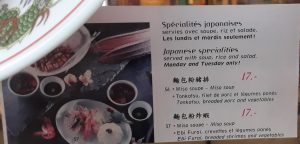 The photo here annexed, which illustrates the restaurant’s window, portrays that the first language is French because the information is first given in French, then in English.
The photo here annexed, which illustrates the restaurant’s window, portrays that the first language is French because the information is first given in French, then in English.
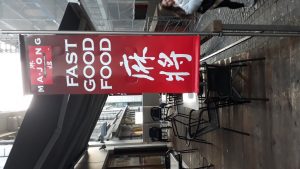 The Chinese is present only in the name of the restaurant and to name the original dishes served in the restaurant.
The Chinese is present only in the name of the restaurant and to name the original dishes served in the restaurant.
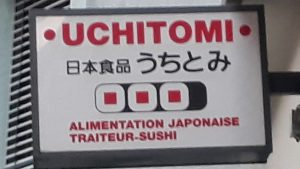 Lastly, the food service Uchitomi presents in its first photo Japanese as a first language and French as a second. This photo is a commercial sign and the Japanese language is visible in the name of the company: “Uchitomi”, a name that we think is a transliteration of the food service’s name in the Latin alphabet. However, French also plays an important role: it explains what this shop sells, namely, “alimentation japonaise traiteur-sushi”.
Lastly, the food service Uchitomi presents in its first photo Japanese as a first language and French as a second. This photo is a commercial sign and the Japanese language is visible in the name of the company: “Uchitomi”, a name that we think is a transliteration of the food service’s name in the Latin alphabet. However, French also plays an important role: it explains what this shop sells, namely, “alimentation japonaise traiteur-sushi”.
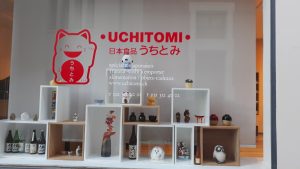 The second “Uchitomi”’s photo presents instead as first language French and as second Japanese. This switch of first and second language is visible in the store’s window where it is written again “alimentation japonaise traiteur-sushi” with also the contacts for the customer: T standing for telephone and F for Fax, meaning that this information must be given in French. In the Asian (Chinese and Japanese) ethnic the importance of their own language (Chinese and Japanese) is important because it characterises to which type of cuisine the customer will be presented to; nevertheless, the fact that they are found in a landscape where Chinese and Japanese are not taught in schools as an obligatory language it makes impossible for an average Swiss customer to understand the products and all the information. As a result, having a secondary language which might be French or English is essential if they want to have profitability. Also, the Italian ethnic is composed by two restaurants and a food service.
The second “Uchitomi”’s photo presents instead as first language French and as second Japanese. This switch of first and second language is visible in the store’s window where it is written again “alimentation japonaise traiteur-sushi” with also the contacts for the customer: T standing for telephone and F for Fax, meaning that this information must be given in French. In the Asian (Chinese and Japanese) ethnic the importance of their own language (Chinese and Japanese) is important because it characterises to which type of cuisine the customer will be presented to; nevertheless, the fact that they are found in a landscape where Chinese and Japanese are not taught in schools as an obligatory language it makes impossible for an average Swiss customer to understand the products and all the information. As a result, having a secondary language which might be French or English is essential if they want to have profitability. Also, the Italian ethnic is composed by two restaurants and a food service.
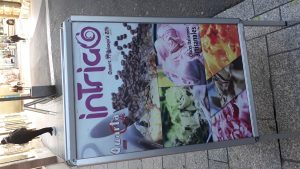 In the food service “Intrigo Gelateria Lausanne”, the first languages is French while, as second is Italian. Even if in the commercial sign the bigger language written and mostly visible is Italian, “Intrigo” and “Quarta – Lecce”, all the information such as opening hours and the products sold (“Glaces italiennes artisanales”) are written in French. Therefore, Italian is only used to name the place.
In the food service “Intrigo Gelateria Lausanne”, the first languages is French while, as second is Italian. Even if in the commercial sign the bigger language written and mostly visible is Italian, “Intrigo” and “Quarta – Lecce”, all the information such as opening hours and the products sold (“Glaces italiennes artisanales”) are written in French. Therefore, Italian is only used to name the place.
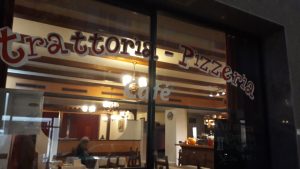
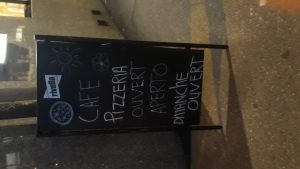
The restaurant “Giovanni Paolini” presents in its restaurant’s window and commercial sign as primary language French, while as second Italian. The name of the restaurant clearly underlines its origins and the word “Trattoria – Pizzeria” also emphasises the “italianess” of the restaurant. However, most information is written in French (i.e. dishes, even if some are not translated, like “pizza margherita”). Therefore, Italian is only found in the name of the place and in the opening sign (even if it is also translated in French).
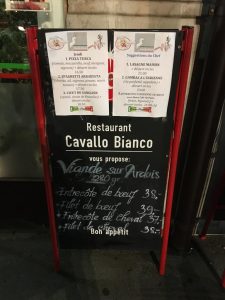 The last Italian restaurant is “Cavallo Bianco” and its commercial sign uses French as main language and Italian as second. The first language is French because all the important information is given in French, while the Italian is relegated only to the name of the restaurant, “Cavallo Bianco” and for dishes which are not translated (i.e. “Spaghetti Arrabbiata”, or “Pizza Turca”).
The last Italian restaurant is “Cavallo Bianco” and its commercial sign uses French as main language and Italian as second. The first language is French because all the important information is given in French, while the Italian is relegated only to the name of the restaurant, “Cavallo Bianco” and for dishes which are not translated (i.e. “Spaghetti Arrabbiata”, or “Pizza Turca”).
The last group collected is the mixed one and it is composed of one French Restaurant, “Luncheonette Café” which has as a first Language French and as second language English; one American food service “Starbucks”, composed by French as its first language and English as second; one Spanish restaurant “El Chiringuito” and one Spanish food service.
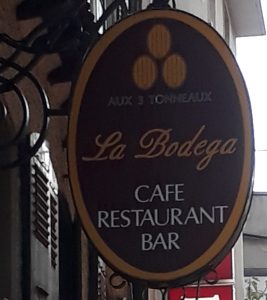 Regarding the Spanish food service, it is difficult to establish whether it is called “La Bodega” or “Aux 3 tonnaux”, that are not translations of each other. According to the website TripAdvisor, the food service is called in the French name, hence, in this case the primary language is French, but since, in the photo right under the French name there is in big characters “La Bodega”, we think that the name of the place is in the Spanish language. Therefore, “La Bodega” and “El Chiringuito” both have also French as its first language and Spanish as secondary language. “La Bodega” has as its secondary language Spanish because it only denotes the place’s name, indeed all the other information are written in French. Furthermore, in small characters there is also written in French “aux 3 tonnaux”.
Regarding the Spanish food service, it is difficult to establish whether it is called “La Bodega” or “Aux 3 tonnaux”, that are not translations of each other. According to the website TripAdvisor, the food service is called in the French name, hence, in this case the primary language is French, but since, in the photo right under the French name there is in big characters “La Bodega”, we think that the name of the place is in the Spanish language. Therefore, “La Bodega” and “El Chiringuito” both have also French as its first language and Spanish as secondary language. “La Bodega” has as its secondary language Spanish because it only denotes the place’s name, indeed all the other information are written in French. Furthermore, in small characters there is also written in French “aux 3 tonnaux”.
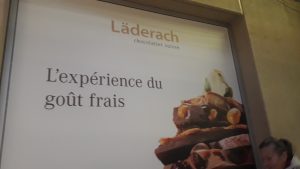 Finally, there is a Swiss-German food service, Läderach, which possesses as first languages French and English and as second German. The German language is only used in the name of the place and it is not present elsewhere. Instead, French and English are equally represented: French used directly under the name “chocolatier Suisse” and on a sign “L’expérience du gout frais”, whereas English is on a smaller sign attached to the window saying, “the art of caramel”.
Finally, there is a Swiss-German food service, Läderach, which possesses as first languages French and English and as second German. The German language is only used in the name of the place and it is not present elsewhere. Instead, French and English are equally represented: French used directly under the name “chocolatier Suisse” and on a sign “L’expérience du gout frais”, whereas English is on a smaller sign attached to the window saying, “the art of caramel”.
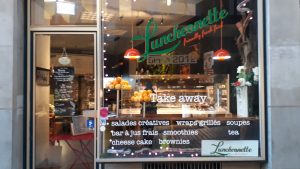 The Cafe’s window of the Luncheonette Café the French language conveys what is it sold, while English information typically known and used as “Take Away” and “Since 2012”.
The Cafe’s window of the Luncheonette Café the French language conveys what is it sold, while English information typically known and used as “Take Away” and “Since 2012”.

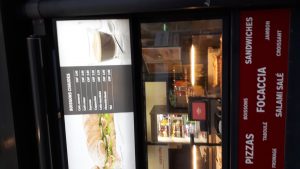 In Starbucks instead, French is used only in the commercial sign because it is written in big, but all the drinks are named in English.
In Starbucks instead, French is used only in the commercial sign because it is written in big, but all the drinks are named in English.
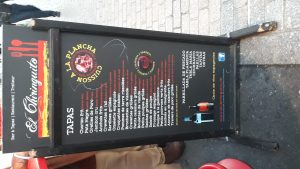 El Chiringuito’s commercial sign portrays that every meal is firstly written in French and then in smaller characters in Spanish. However, Spanish is present everywhere in this sign: from the name of the Restaurant to the name of the dishes and other dishes in the lower side of the sign.
El Chiringuito’s commercial sign portrays that every meal is firstly written in French and then in smaller characters in Spanish. However, Spanish is present everywhere in this sign: from the name of the Restaurant to the name of the dishes and other dishes in the lower side of the sign.
Discussion
It is difficult to answer the research question, whether the ethnic restaurant succeeded on reclaiming their own culture through their language(s) in a place where those languages are not officially recognised. Since there are not previous works which also analysed this aspect, the answer of this question is debatable. One answer might be yes: they succeed thanks to the name of the places, which most of the time is in the first language of the ethnic group. Nevertheless, it is not possible to define if only the name’s place is enough to establish the claim of culture. To reconnect to what Muñoz and Wood said about the authenticity, in the photos collected the landscape which surrounds the restaurants or food services helps to define whether the ethnic culture is claimed or not. One example is the food service “Uchitomi” which in its commercial signs portrays the image of a panda, the typical animal which represents the “Asian culture”. However, according to us what really depicts the claim of culture is the presence of the native language: the Italian group portrays successfully, in the name of the place, Italian words which gives immediately the perception of the typical Italian place; everyone knows what a “Pizzeria” is and immediately thinks of Italy. However, by looking only at the language, it is difficult to establish if the claim is succeeded or not. Unfortunately, the research concerns only the languages visible in commercial signs, store’s windows and so on, therefore, there is not a direct analysis on the “inside” of the place. It is impossible to define if the place is really “authentic” and claims the culture because, for instance, there is not a declaration whether waiters and waitress uses the native language (i.e. Italian) with customers (we believe that a questionnaire to the restaurant’s owner and workers would have answered this kind of questions). As a result, with the little data collected, we think that the groups who really succeeded on assessing their status of foreign culture as ethnic restaurants are food services which claims Italian and Asians (Chinese and Japanese) origins, because, firstly, they are the most recurrent ones (i.e. it is easier to find a Chinese restaurants than Spanish ones) and because they are the ones which do a heavier use of their primary language.
Conclusion
The data collected has been gathered in three groups: the Asian ethnic (composed of two restaurants, which respectively possess as first language Chinese and French and English, while as second French and Chinese, and one food service which has as first language Japanese and French and as second Japanese and French); the Italian ethnic (composed of two restaurants, which both possess French as primary language and Italian as secondary and a food service, which instead as first language possesses both French and Italian) and finally, the Mixed group (composed of a German food service with French and English as primary language and German as secondary; an American chain “Starbucks” with French as first language and English as second; a French restaurant with French as first language and English as second and finally, a Spanish restaurant and a Spanish food service which both have French as first language and Spanish as second).
Unfortunately, this paper had many limitations. The first and most important one is the very restricted data that was collected: only 11 restaurants and food services are not enough to generalize the results to a more general level (especially not on a national level). Moreover, we did not collect eleven specific ethnic restaurants (as i.e. eleven Chinese restaurants, in order to compare one to another one): we gathered all kinds of instances of multilingualism, which reduced even more the validity of our results. It is possible that an analysis that only takes in consideration Asian or Italian restaurants will show differences. Another limitation is the complete lack of literature on how multilingualism in ethnic restaurants works to enhance the culture of the owner (his/her own or the product of both his/her place of origins and the place in which s/he resides now), nor how customers perceive the different language. The body of literature focused more on the restaurant as a whole, trying to problematize how individuals perceive décor in general (décor is here meant as the external and internal look of the restaurant, the language used, the type of furniture that the restaurant displays, …), and not on the specifics of the language and how it works. Yet another big limitation is the fact that we did not have access to the owner’s reasoning while staging the restaurant: we believe that a questionnaire about what the use of two or more languages means for the owner would be a source of knowledge extremely important in this kind of researches. Moreover, we did not include in our research what customers think about the language used: considering that most customers will not be able to read i.e. Chinese, how would this lack of knowledge impact on their choice? Will they be less attracted by the restaurant if there was not any Chinese attesting its true origins? Will they be neutral to that? These are answers to which we cannot know or respond with our present researches.
We strongly believe that future researches, when analysing ethnic restaurants and their impact, should really focus on the use of different languages: how do they work, what customers perceive them to be, and what do they stand for the owner and the workers.
Bibliography
Ebster, C., & Guist, I., 2005. The role of authenticity in ethnic theme restaurants. Journal of Foodservice Business Research 7.2, 41-52.
Gorter, D. 2006. Further possibilities for linguistic landscape research. International Journal Multilingualism 3.2, 81-89.
Gorter, D., & Cenoz, J. 2017. Linguistic landscape and multilingualism. In: Cenoz, J., et al. (eds.). Language Awareness and Multilingualism. 3rd edition. Switzerland: Springer, 233-245.
Gorter, D., Marten, H. F., & Van Mensel, L. (Eds.). 2012. Minority Languages in the Linguistic Landscape. Basingstoke: Palgrave-McMillan.
Harris, K.J. 2016. Culture and theory: considerations for the ethnic restaurant and food safety culture. Athens Journal of Tourism 3.4, 263-272.
Jang, S.S., Liu, Y. & Namkung, Y. 2011. Effects of authentic atmospherics in ethnic restaurants: investigating Chinese restaurants. International Journal of Contemporary Hospitality Management 23.5, 662-680.
Lego, C.K., Wodo, N.T., McFee, S.L.& Solomon, M.R. 2002. A thirst of the real thing in themed retail environments. Journal of Foodservice Business Research 5.2, 61-74.
Lu, S., & Fine, G.A. 1995. The presentation of ethnic authenticity: Chinese food as a social accomplishment. The Sociological Quarterly 36.3, 535-553.
Lu, A.C.C., Gursoy, D., & Lu, C.Y. 2015. Authenticity perceptions, brand equity and brand choice intention: the case of ethnic restaurants. International Journal of Hospitality Management 50, 36-45.
Muñoz, N.L., & Wood, N.T. 2009. A recipe for success: understanding regional perceptions of authenticity in themed restaurants. International Journal of Culture, Tourism and Hospitality Research 3.3, 269-280.
Roseman, M.G. 2006. Changing times: consumers choice of ethnic foods when eating at restaurants. Journal of Hospitality & Leisure Marketing 14.4, 5-32.
Website
TripAdvisor, https://www.tripadvisor.com/Home-g188107 , accessed on 28.12.18.
[1] Uchitomi:
https://www.tripadvisor.com/Restaurant_Review-g188107-d4096504-Reviews-Uchitomi-Lausanne_Canton_of_Vaud.html→ accessed on 28.12.18 at 12:20.
Ningbo:
https://www.tripadvisor.com/Restaurant_Review-g188107-d5987219-Reviews-Ningbo-Lausanne_Canton_of_Vaud.html→ accessed on 28.12.18 at 12:20.
Ma Jong SA: https://www.tripadvisor.com/Restaurant_Review-g188107-d787495-Reviews-Ma_jong_SA-Lausanne_Canton_of_Vaud.html→ accessed on 28.12.18 at 12:22.
[2]
Intrigo:
https://www.tripadvisor.com/Restaurant_Review-g188107-d3929426-Reviews-Intrigo-Lausanne_Canton_of_Vaud.html→ accessed on 28.12.18 at 12:24.
Cavallo Bianco:
https://www.tripadvisor.com/Restaurant_Review-g188107-d3307857-Reviews-Cavallo_Bianco-Lausanne_Canton_of_Vaud.html→ accessed on 28.12.18 at 12:31.
Giovanni Paolini:
https://www.tripadvisor.com/Restaurant_Review-g188107-d11709718-Reviews-Restaurant_chez_Giovanni-Lausanne_Canton_of_Vaud.html→ accecsso 28.12.18 12.30.
[3]
Starbucks
https://www.tripadvisor.com/Restaurant_Review-g188107-d7112549-Reviews-Starbucks-Lausanne_Canton_of_Vaud.html→ accessed on 28.12.18 at 12:27.
[4] La Bodega:
https://www.tripadvisor.com/Restaurant_Review-g188107-d2337043-Reviews-Aux_Trois_Tonneaux-Lausanne_Canton_of_Vaud.html→ accessed on 28.12.18 at 14:30.
[5] Luncheonette Café:
https://www.tripadvisor.com/Restaurant_Review-g188107-d4882924-Reviews-Luncheonette-Lausanne_Canton_of_Vaud.html→ accessed on 28.12.18 at 12:26.
[6] El Chiringuito:
https://www.tripadvisor.com/Restaurant_Review-g188107-d4827523-Reviews-El_Chiringuito-Lausanne_Canton_of_Vaud.html→ accessed on 28.12.18 at 12:28
Appendices
Ningbo



Majong
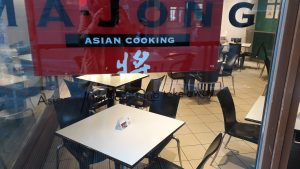

Intrigo

La Bodega

Uchitomi


Launcheonnette


Starbucks


El Chiringuito

Cavallo Bianco
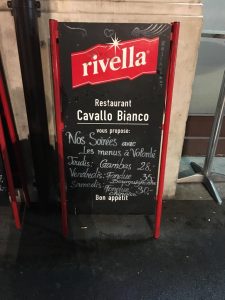

Giovanni Paolini
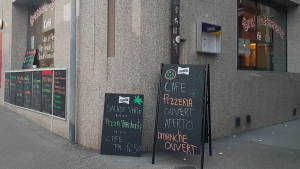


Läderach
